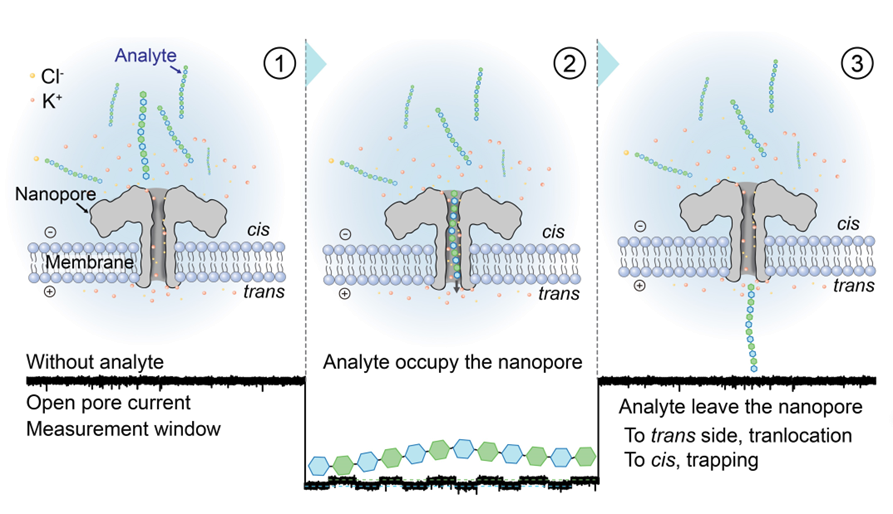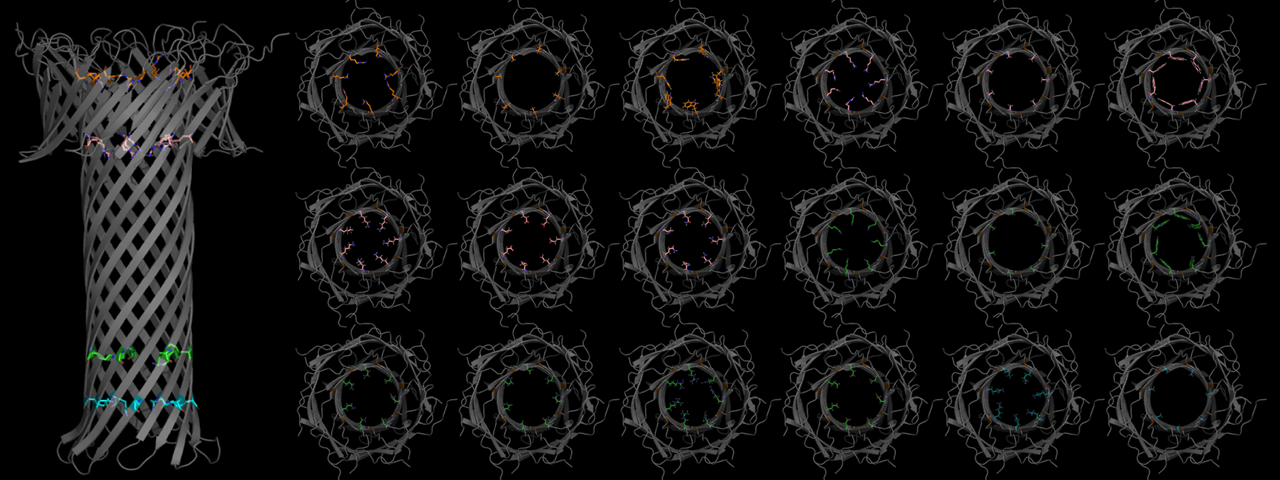Research
 Nanopore sensing
Nanopore sensing
Single-molecule sequencing
Molecular Dynamics Simulation
Engineering and design nanopores
Rapid on-site detection
Nanopore sensing
The nanopore technique is an electrophoretic approach that can identify a single molecule as it passes through a nanometer-scale pore. By measuring the ionic current induced by the target molecule, the chemical and physical properties of the molecule can be obtained, including its size, mass, composition, structure, sequence, and conformation.
The nanopore technique offers several unique advantages as an analytical tool. It does not require additional labelling and amplification, and it provides an electric readout that is inexpensive and can be easily and massively parallelized for high-throughput analysis. Furthermore, the technique measures the ionic current difference induced by the target molecule, which is a fundamentally different principle compared to other techniques. As a result, it can provide additional and potentially more comprehensive information about the detected molecules. Additionally, the nanopore technique can directly detect mixture samples without the need for additional separation steps, as each protein or peptide has its own characteristic ionic current signature. Finally, biological nanopore results are highly reproducible; once standard samples are measured by certain nanopores, a database could be built.

Single-molecule sequencing
Biological nanopores have been successfully applied in DNA sequencing, which has revolutionized the development of precision medicine. Among all kinds of pore materials, including both biological and solid-state materials, aerolysin is one of the most promising one for identifying the subtle difference of detected molecules due to the geometry and electrostatic features of its channel. Several works have shown aerolysin’s exceptionally high sensitivity, dwell time and signal to noise ratio for analytes like DNA, peptides and polymers. Aerolysin also has four constriction points that can be further engineered, allowing for improvement of the accuracy in the nanopore-based sequencing approach. Meantime, the great success of nanopore sensing in DNA sequencing has inspired its application for protein and other polymer sequencing, which is an exciting field to explore. Herein, we are also developing strategies for sequencing protein and digital polymers using our nanopore platform.
Molecular Dynamics Simulation
Molecular dynamics simulations allow computing a system's behavior at an atomic level. By studying a system such as a nanopore at that scale, it is possible to identify the regions in a pore that are responsible for a blockage or reduction of the ionic current, thus providing insight into what type of mutation would be helpful to improve the characteristics of a nanopore. More broadly, molecular dynamics also make it possible to study various molecules' interactions, such as the interaction between a protein or a DNA strand with a nanopore, which again can help to understand experimental data at a much smaller scale.

Engineering and design nanopores
Nanopore sensing and sequencing is a powerful approach for detecting various biological and synthetic molecules, sequencing long strands of DNA, and sensing proteins and peptides at the single-molecule level. To achieve this, many proteins have been utilized as biological nanopore sensors. Each of these sensors is unique and plays a vital role in specific applications of molecular sensing. As nanopore technology has been widely applied in many fields, there is a need for novel biological nanopores. To meet this demand, we are seeking new candidates and then to improve or reinvent them through molecular engineering and design.

Rapid on-site detection
As nanopore technique is cheap and able to be integrated to a portable device, it has great potential on rapid on-site detection. For instance, biomarker detection. Biomarkers is a measurable indicator of a specific biological state, the presence or the stage of disease. Better biomarkers are urgently needed to improve diagnosis, guide molecularly targeted therapy and monitor activity and therapeutic response across a wide spectrum of disease. However, only a handful of techniques are available for biomarker discovery and validation, and the low sensitivity and selectivity of existing techniques limit their application. Single-molecule nanopore technique has the potential to revolutionize proteomics, providing high sensitivity for the detection of low-abundance proteins and high specificity in mixtures. With a large library of engineered aerolysin nanopores we have built, we are targeting to develop a nanopore-based platform for the detection of potential biomarkers.
